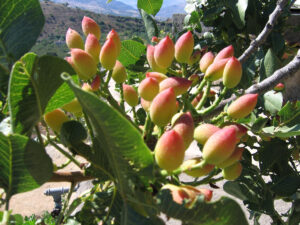Pistachio

GROUND
The pistachio or Pistacia vera belongs to the Anarcadiaceae family, it is very vigorous and in nature it reaches an average of 4-5 meters. Pistachio prefers sunny areas and mild climatic conditions to grow adequately and bear fruit at its best. During the year it must not be exposed to temperatures below 7 ° C, except in winter when, being in the vegetative rest, it can withstand even -10 ° C. It resists drought very well and therefore does not tolerate abundant irrigation and stagnation of water. It grows well in all soils even in those poor in mineral salts, such as calcium, or in the more calcareous or volcanic ones. In general, pistachio is a rustic plant that does not require special care. As always, it is advisable to carry out adequate chemical-physical analyzes of the soil to identify the values of chemical and organic fertilizers to be applied. In general, as regards the organic substance, it can be buried beforehand when the soil is being worked on. From 300 to 400 quintals of manure are used per hectare of land, to which simple phosphorus superphosphate (about 12 quintals per hectare) and potassium sulphate (about 5 quintals per hectare) will be added.
The annual fertilization interventions foresee an administration in April in correspondence with the vegetative restart phase with nitrogen and then subsequently in the month of May a complete ternary fertilizer can be administered.
FIORI E FRUTTI
The crown is wide and with pendulous branches. The leaves are compound, deciduous, imparipinnate and glabrous (tomentose in young plants). Pistachio is a dioecious plant and blooms in April-May, preceding the release of the leaves. The flowers are devoid of petals and carried by axillary inflorescences in the shape of a panicle; the female ones are similar to a very small fruit with trifid, keeled, enlarged and papillose stigma, while the male ones are provided with bracts and large anthers. The fruit is a monosperm drupe, with a thin, pedunculated and oval-shaped husk. The seed, contained in two cream yellow or whitish valves, is elongated, light green in color and rich in oil and proteins. The harvest of the fruits generally takes place in a gradual manner starting from August and until the end of September. It is made by hand, at times, with the help of tarps or nets. The pistachio tree goes into production rather late, usually from the 5th-7th year of age. From the 10th year it enters the phase of full productivity which lasts for another 20-30 years. A plant produces an average of 7-10 kg, with peaks that can reach 30 kg.
After harvesting, the fruits must be deprived of the husk and left to dry in the sun for a few days. This lasts 3-4 days. The pistachio in shell is then stored in jute bags in dark and dry rooms. The shelled pistachios, on the other hand, need to be roasted in order to be preserved.
Pistachio plants are planted in late autumn or winter, when they are dormant. The pistachio tree is raised using the free pot shape, more or less open and laid at 80-100 cm, with an investment of plants of about 100-280 plants per hectare (sixths in a framework of 6-10 meters x 6 -10 meters). Pruning operations tend to be limited as, especially the large branches, they heal very slowly. Production pruning must take into account the fact that the pistachio tree produces on 2-year-old branches: so at the end of winter, a slight thinning of the crown is enough, eliminating dry and decayed branches. In some cases, green pruning interventions are also implemented, such as scacchiatura and desollonatura. It is also important to remember how pistachio is subject to alternation of production: for this reason, in the years of discharge it is possible to intervene by pruning more decisively, limiting instead the interventions in good years.
The irrigation of pistachio in the adult phase can be limited to the period of greatest summer heat. The situation may be different in younger plants where, starting from spring, small and repeated water supplies can help the plant to grow at its best. Based on bibliographic data, plants up to 8 years of age have a water requirement of between 1200-1800 liters of water per year. Today, in specialized pistachio groves, irrigation is carried out with drip systems.
